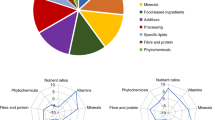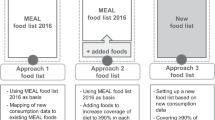Abstract
Background/Objectives:
Food composition data (FCD) can provide important information in relation to diet and health; therefore, data on food composition have broad applications in health care. The objective of this study was to provide an overview of added-value eHealth systems that use modern information and communication technologies to support health and are related to FCD and nutrition. This paper also examines whether reliable and comprehensive FCD are used in eHealth systems.
Methods:
A total of 25 instances of eHealth systems from nine groups, defined with respect to the services that eHealth systems provide, were randomly selected. The selection of the population-based and expert-based eHealth systems took into account diversity, complexity and popularity.
Results/Conclusions:
As most of the reviewed population-based eHealth systems used the United States Department of Agriculture nutrient database or basic FCD provided by the food products’ producers, and only a few of them relied on local or national FCD, the author believes that, in general, the use of comprehensive FCD in the reviewed population-based eHealth systems has not reached a satisfactory level. Furthermore, many of these systems would increase their value by providing more detailed information on FCD and by addressing the nutritional aspects of health with greater emphasis. In contrast, most of the reviewed expert-based eHealth systems proved to be reliable and rich sources of nutrition information, respecting the need to address the subject from both national and international aspects.
This is a preview of subscription content, access via your institution
Access options
Subscribe to this journal
Receive 12 print issues and online access
$259.00 per year
only $21.58 per issue
Buy this article
- Purchase on SpringerLink
- Instant access to full article PDF
Prices may be subject to local taxes which are calculated during checkout
Similar content being viewed by others
References
Adelmann R (2008). BaToo—Enabling the rapid prototyping of mobile services to retail products. In: Floerkemeier C, Langheinrich M, Fleisch E, Mattern F, Sarma SE (eds.) Adjunct Proceedings of Internet of Things (IOT08). Lecture Notes in Computer Science, Vol. 4952. Springer: Zurich, Switzerland, pp 114–117.
Bourgeios FT, Simons WW, Olson K, Brownstein JS, Mandl KD (2008). Evaluation of influenza prevention in the workplace using a personally controlled health record: randomized controlled trial. J Med Internet Res 10, 1–11.
Carpenter KJ (2003). A short history of nutritional science: part 1–4. American Society for Nutritional Sciences. J Nutr 133, 638–645; 975-984; 3023-3032; 3331-3342.
Cobb NK, Graham AL, Bock BC, Papandonatos G, Abrams DB (2005). Initial evaluation of a real-world internet smoking cessation system. Nicotine Tob Res 7, 207–216.
Cullen KW, Thomson D (2008). Feasibility of an 8-week African American web-based pilot program promoting healthy eating behaviors: family eats. Am J Health Behav 32, 40–51.
Ehealth week (2010). Conference declaration: European co-operation on eHealth. Available at: http://ehealthweek2010.wordpress.com/2010/03/15/conference-declaration-european-co-operation-on-ehealth/.
Eysenbach G (2001). What is e-health? J Med Internet Res 3, e20. Available at: http://www.jmir.org/2001/2/e20/.
Eysenbach G (2008). Medicine 2.0: Social networking, collaboration, participation, apomediation, and openness. J. Med. Internet Res. 10, e22. Available at: http://www.jmir.org/2008/3/e22/.
Eysenbach G, Powell J, Kuss O, Sa E (2002). Empirical studies assessing the quality of health information for consumers on the world wide web: a systematic review. JAMA 287, 2691–2700.
Gaal B, Vassnyi I, Kozmann G (2005). A novel artificial intelligence method for weekly dietary menu planning. Methods Inf Med 44, 655–664.
Hovorka R, Chassin LJ, Wilinska ME, Canonico V, Akwi JA, Federici MO et al. (2004). Closing the loop: the ADICOL experience. Diabetes Technol Ther 6, 307–318.
Hughes B, Joshi I, Wareham J (2008). Health 2.0 and Medicine 2.0: tensions and controversies in the field. J Med Internet Res 10, e23. Available at: http://www.jmir.org/2008/3/e23/.
Hunter C, Peterson A, Alvarez L, Poston W, Brundige A, Haddock C et al. (2008). Weight management using the internet—a randomized controlled trial. Am J Prev Med 34, 119–126.
Järvinen T (2005). Hybridmedia as a tool to deliver personalised product-specific information about food, Report of the TIVIK project. VTT Information Technology.
Koch S (2006). Home telehealth–current state and future trends. Int J Med Inform 75, 565–576.
Koroušić Seljak B (2009). Computer-based dietary menu planning. J Food Compos Anal 22, 1650–1655.
Krupinski E, Dimmick S, Grigsby J, Mogel G, Puskin D, Speedie S et al. (2006). Telemed E Health 12, 579–589. doi:10.1089/tmj.2006.12.579.
Lorig KR, Lorig K, Ritter PL, Laurent DD, Plant K (2006). Internet-based chronic disease self-management: a randomized trial. Med Care 44, 964–971.
Mandil SH (2005). eHealth: its evolution from medical informatics, and its value to health care. Invited presentation to the ICML9/CRICS7 Conference, Salvador, Bahia, Brazil. Available at: http://www.icml9.org/program/.
Marcus BH, Lewis BA, Williams DM, Dunsiger S, Jakicic JM, Whiteley JA et al. (2007). A comparison of internet and print-based physical activity interventions. Arch Intern Med 167, 944–949.
Olla P, Tan J (eds). (2009). Mobile health solutions for biomedical applications (advances in healthcare information systems and informatics). Medical Information Science Reference.
Siek KA, Connely KH, Chaudry B, Lambret D, Welch JL (2009). Evaluation of two mobile nutrition tracking applications for chronically ill populations with low literacy skills. IGI Global: Hershey, Pennsylvania.
Sobotka L (2004). Basics in clinical nutrition. 3rd edn. Publishing House: Galén, Praga.
USDA (United States Department of Agriculture) (2008). USDA palm OS search. Nutrient Data Laboratory, U.S. Department of Agriculture, Agricultural Research Service: Nutrient Data Laboratory, Beltsville.
Williamson C (2006). The different uses of food composition databases, EuroFIR synthesis report No. 2.
WHO Global Observatory for eHealth (2006). eHealth TOOLS&SERVICES, needs of the member states. Report of the WHO Global Observatory for eHealth. Available at: http://www.who.int/kms/initiatives/ehealth/en/.
Acknowledgements
The author is grateful to the reviewers and the editors for invaluable assistance in the final preparation and review of the paper.
Author information
Authors and Affiliations
Corresponding author
Ethics declarations
Competing interests
The authors declare no conflict of interest.
Rights and permissions
About this article
Cite this article
Koroušić Seljak, B. Web-based eHealth applications with reference to food composition data. Eur J Clin Nutr 64 (Suppl 3), S121–S127 (2010). https://doi.org/10.1038/ejcn.2010.222
Published:
Issue Date:
DOI: https://doi.org/10.1038/ejcn.2010.222



